CHCDIV001 - TAFE NSW Knowledge Assessment: Work with Diverse People
VerifiedAdded on 2023/06/18
|35
|5965
|255
Homework Assignment
AI Summary
This document presents a comprehensive solution to a knowledge assessment for the CHCDIV001 unit, focusing on working with diverse people in Australia. It addresses key aspects such as Australia's diverse characteristics (birthplace, language, religion), the impact of diversity on work and life (political, social, economic, cultural), and the social, economic, and cultural barriers faced by Aboriginal and Torres Strait Islander peoples in accessing services. Furthermore, it explores the potential needs of marginalized groups, including protection, physical and mental health care, trauma support, and addressing exclusion and negative attitudes. The assessment also covers the use of language and cultural interpreters, providing real-world examples, and identifies changing cultural practices in Australia, their influences, and their societal impact, specifically mentioning the influence of Western culture and geography on Australian etiquette and customs.

1. Knowledge
Assessment
Criteria
Unit code, name and release number
Qualification/Course code, name and release number
Select qualification from drop-down list
Assessment Declaration
This assessment is my original work and no part of it has been copied from any other
source except where due acknowledgement is made.
No part of this assessment has been written for me by any other person except where
such collaboration has been authorised by the assessor concerned.
I understand that plagiarism is the presentation of the work, idea or creation of another
person as though it is your own. Plagiarism occurs when the origin of the material used is
not appropriately cited. No part of this assessment is plagiarised.
This declaration only needs to be completed if you are not submitting your assessment
online.
Student signature and date
Assessment
Criteria
Unit code, name and release number
Qualification/Course code, name and release number
Select qualification from drop-down list
Assessment Declaration
This assessment is my original work and no part of it has been copied from any other
source except where due acknowledgement is made.
No part of this assessment has been written for me by any other person except where
such collaboration has been authorised by the assessor concerned.
I understand that plagiarism is the presentation of the work, idea or creation of another
person as though it is your own. Plagiarism occurs when the origin of the material used is
not appropriately cited. No part of this assessment is plagiarised.
This declaration only needs to be completed if you are not submitting your assessment
online.
Student signature and date
Paraphrase This Document
Need a fresh take? Get an instant paraphrase of this document with our AI Paraphraser
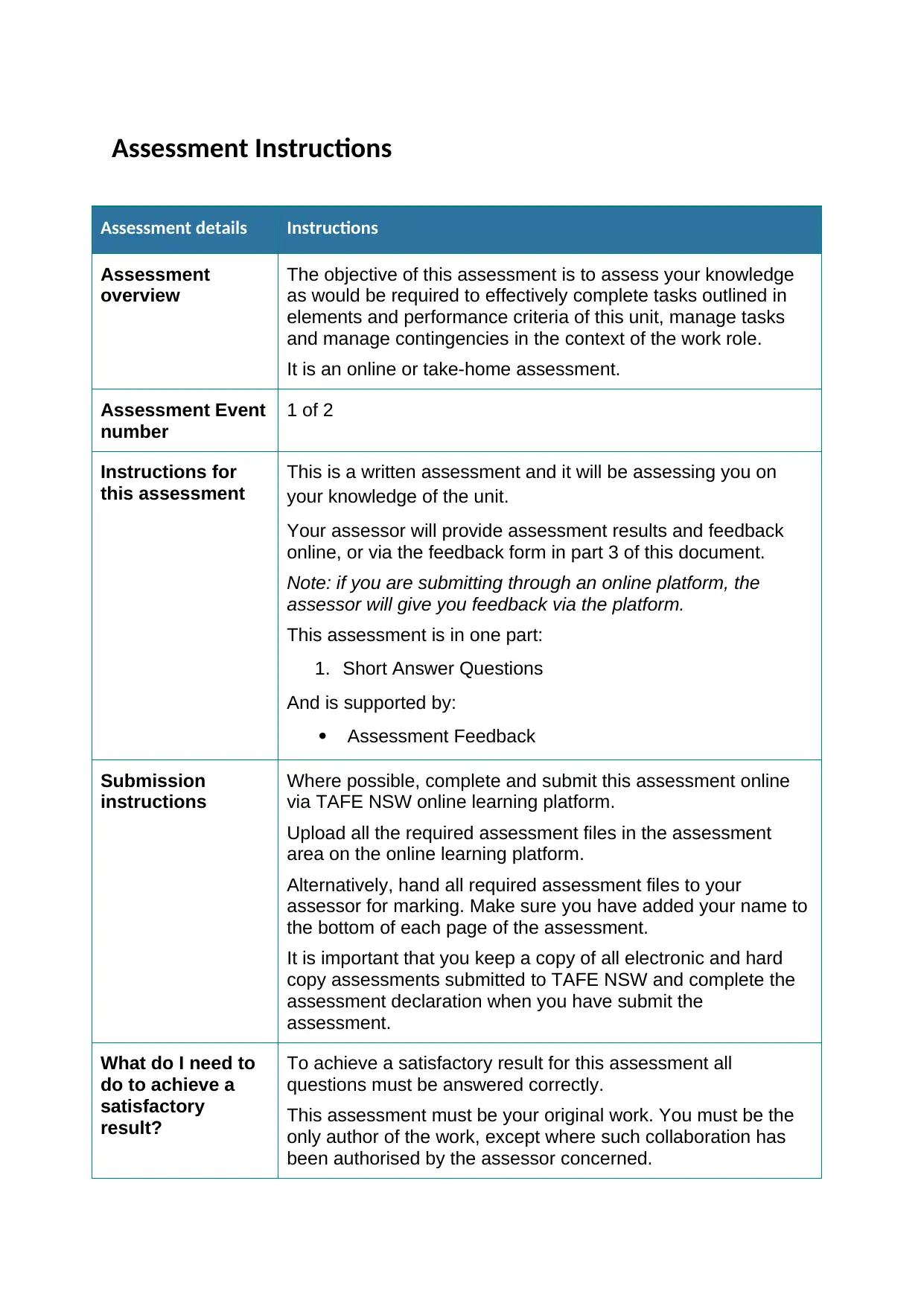
Assessment Instructions
Table 1 Assessment instructions
Assessment details Instructions
Assessment
overview
The objective of this assessment is to assess your knowledge
as would be required to effectively complete tasks outlined in
elements and performance criteria of this unit, manage tasks
and manage contingencies in the context of the work role.
It is an online or take-home assessment.
Assessment Event
number
1 of 2
Instructions for
this assessment
This is a written assessment and it will be assessing you on
your knowledge of the unit.
Your assessor will provide assessment results and feedback
online, or via the feedback form in part 3 of this document.
Note: if you are submitting through an online platform, the
assessor will give you feedback via the platform.
This assessment is in one part:
1. Short Answer Questions
And is supported by:
Assessment Feedback
Submission
instructions
Where possible, complete and submit this assessment online
via TAFE NSW online learning platform.
Upload all the required assessment files in the assessment
area on the online learning platform.
Alternatively, hand all required assessment files to your
assessor for marking. Make sure you have added your name to
the bottom of each page of the assessment.
It is important that you keep a copy of all electronic and hard
copy assessments submitted to TAFE NSW and complete the
assessment declaration when you have submit the
assessment.
What do I need to
do to achieve a
satisfactory
result?
To achieve a satisfactory result for this assessment all
questions must be answered correctly.
This assessment must be your original work. You must be the
only author of the work, except where such collaboration has
been authorised by the assessor concerned.
Table 1 Assessment instructions
Assessment details Instructions
Assessment
overview
The objective of this assessment is to assess your knowledge
as would be required to effectively complete tasks outlined in
elements and performance criteria of this unit, manage tasks
and manage contingencies in the context of the work role.
It is an online or take-home assessment.
Assessment Event
number
1 of 2
Instructions for
this assessment
This is a written assessment and it will be assessing you on
your knowledge of the unit.
Your assessor will provide assessment results and feedback
online, or via the feedback form in part 3 of this document.
Note: if you are submitting through an online platform, the
assessor will give you feedback via the platform.
This assessment is in one part:
1. Short Answer Questions
And is supported by:
Assessment Feedback
Submission
instructions
Where possible, complete and submit this assessment online
via TAFE NSW online learning platform.
Upload all the required assessment files in the assessment
area on the online learning platform.
Alternatively, hand all required assessment files to your
assessor for marking. Make sure you have added your name to
the bottom of each page of the assessment.
It is important that you keep a copy of all electronic and hard
copy assessments submitted to TAFE NSW and complete the
assessment declaration when you have submit the
assessment.
What do I need to
do to achieve a
satisfactory
result?
To achieve a satisfactory result for this assessment all
questions must be answered correctly.
This assessment must be your original work. You must be the
only author of the work, except where such collaboration has
been authorised by the assessor concerned.
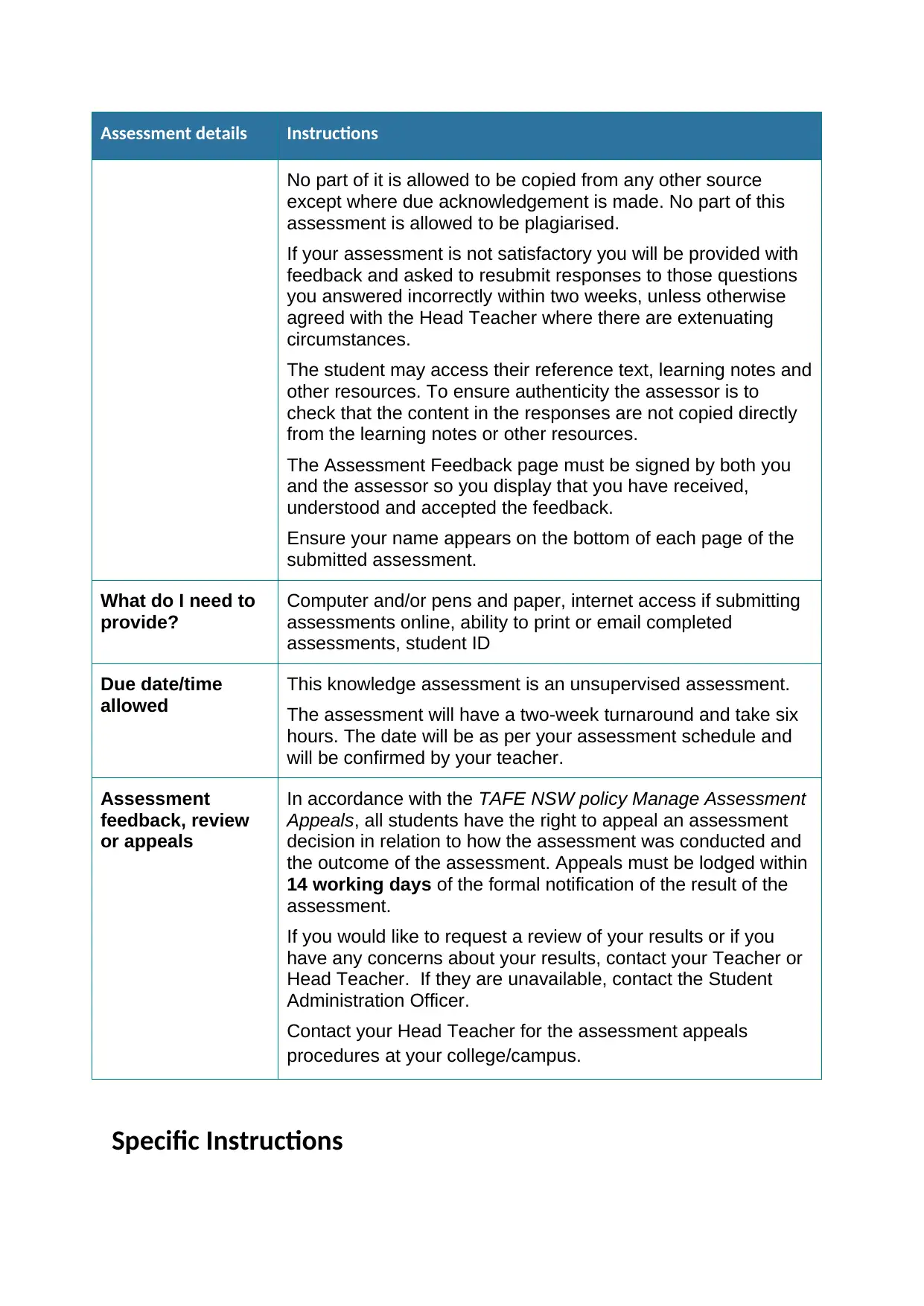
Assessment details Instructions
No part of it is allowed to be copied from any other source
except where due acknowledgement is made. No part of this
assessment is allowed to be plagiarised.
If your assessment is not satisfactory you will be provided with
feedback and asked to resubmit responses to those questions
you answered incorrectly within two weeks, unless otherwise
agreed with the Head Teacher where there are extenuating
circumstances.
The student may access their reference text, learning notes and
other resources. To ensure authenticity the assessor is to
check that the content in the responses are not copied directly
from the learning notes or other resources.
The Assessment Feedback page must be signed by both you
and the assessor so you display that you have received,
understood and accepted the feedback.
Ensure your name appears on the bottom of each page of the
submitted assessment.
What do I need to
provide?
Computer and/or pens and paper, internet access if submitting
assessments online, ability to print or email completed
assessments, student ID
Due date/time
allowed
This knowledge assessment is an unsupervised assessment.
The assessment will have a two-week turnaround and take six
hours. The date will be as per your assessment schedule and
will be confirmed by your teacher.
Assessment
feedback, review
or appeals
In accordance with the TAFE NSW policy Manage Assessment
Appeals, all students have the right to appeal an assessment
decision in relation to how the assessment was conducted and
the outcome of the assessment. Appeals must be lodged within
14 working days of the formal notification of the result of the
assessment.
If you would like to request a review of your results or if you
have any concerns about your results, contact your Teacher or
Head Teacher. If they are unavailable, contact the Student
Administration Officer.
Contact your Head Teacher for the assessment appeals
procedures at your college/campus.
Specific Instructions
No part of it is allowed to be copied from any other source
except where due acknowledgement is made. No part of this
assessment is allowed to be plagiarised.
If your assessment is not satisfactory you will be provided with
feedback and asked to resubmit responses to those questions
you answered incorrectly within two weeks, unless otherwise
agreed with the Head Teacher where there are extenuating
circumstances.
The student may access their reference text, learning notes and
other resources. To ensure authenticity the assessor is to
check that the content in the responses are not copied directly
from the learning notes or other resources.
The Assessment Feedback page must be signed by both you
and the assessor so you display that you have received,
understood and accepted the feedback.
Ensure your name appears on the bottom of each page of the
submitted assessment.
What do I need to
provide?
Computer and/or pens and paper, internet access if submitting
assessments online, ability to print or email completed
assessments, student ID
Due date/time
allowed
This knowledge assessment is an unsupervised assessment.
The assessment will have a two-week turnaround and take six
hours. The date will be as per your assessment schedule and
will be confirmed by your teacher.
Assessment
feedback, review
or appeals
In accordance with the TAFE NSW policy Manage Assessment
Appeals, all students have the right to appeal an assessment
decision in relation to how the assessment was conducted and
the outcome of the assessment. Appeals must be lodged within
14 working days of the formal notification of the result of the
assessment.
If you would like to request a review of your results or if you
have any concerns about your results, contact your Teacher or
Head Teacher. If they are unavailable, contact the Student
Administration Officer.
Contact your Head Teacher for the assessment appeals
procedures at your college/campus.
Specific Instructions
⊘ This is a preview!⊘
Do you want full access?
Subscribe today to unlock all pages.

Trusted by 1+ million students worldwide

All questions are to be answered. Once completed this assessment is to be
submitted to your assessor for marking.
Throughout this assessment the word client is used. This refers to:
*Any person who is receiving a service from your organization and/ or you are
working with directly. This can include older people, families, children, youth, people
with a disability, people accessing services such as health care/ mental health etc.
submitted to your assessor for marking.
Throughout this assessment the word client is used. This refers to:
*Any person who is receiving a service from your organization and/ or you are
working with directly. This can include older people, families, children, youth, people
with a disability, people accessing services such as health care/ mental health etc.
Paraphrase This Document
Need a fresh take? Get an instant paraphrase of this document with our AI Paraphraser
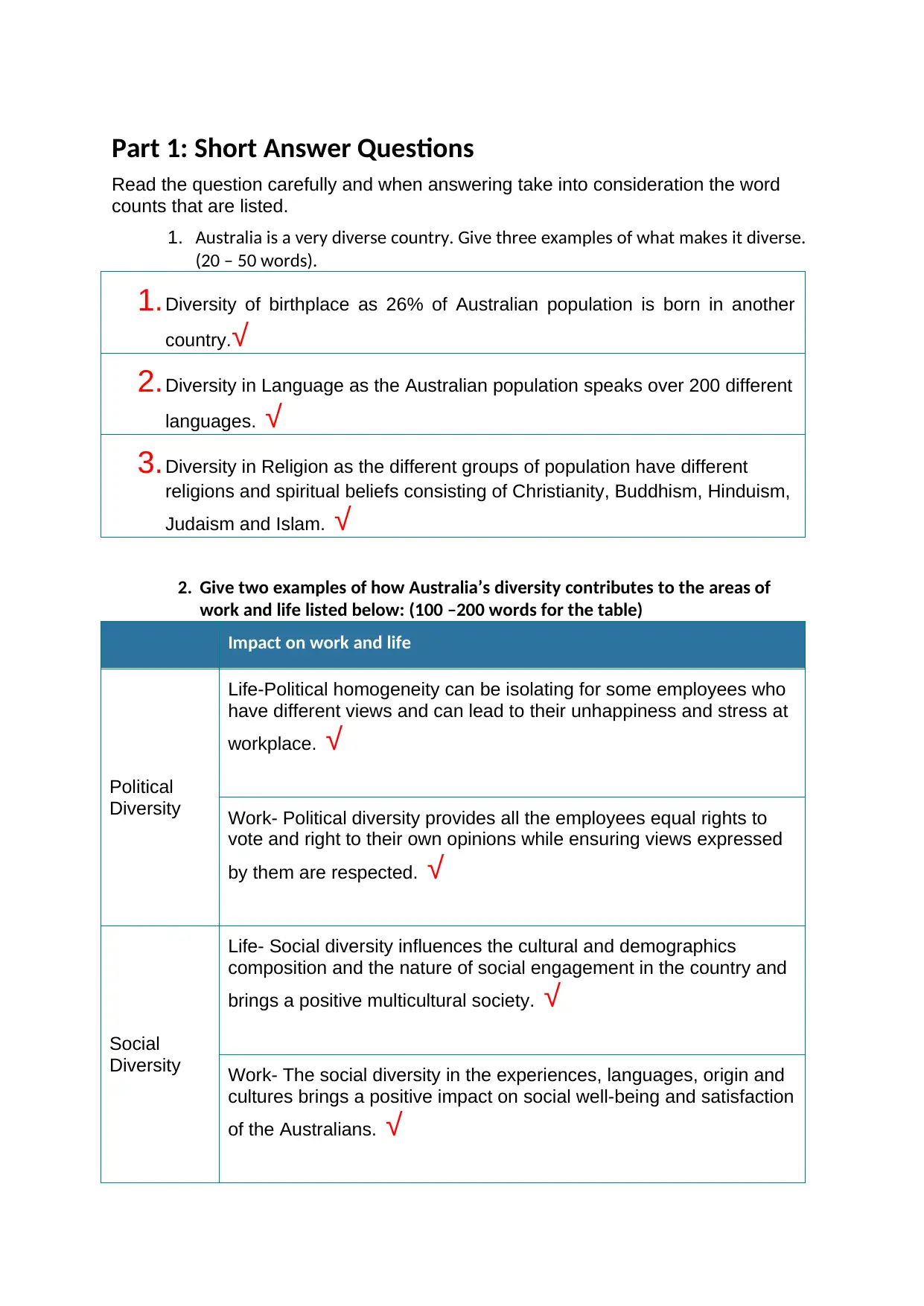
Part 1: Short Answer Questions
Read the question carefully and when answering take into consideration the word
counts that are listed.
1. Australia is a very diverse country. Give three examples of what makes it diverse.
(20 – 50 words).
1.Diversity of birthplace as 26% of Australian population is born in another
country.√
2.Diversity in Language as the Australian population speaks over 200 different
languages. √
3.Diversity in Religion as the different groups of population have different
religions and spiritual beliefs consisting of Christianity, Buddhism, Hinduism,
Judaism and Islam. √
2. Give two examples of how Australia’s diversity contributes to the areas of
work and life listed below: (100 –200 words for the table)
Impact on work and life
Political
Diversity
Life-Political homogeneity can be isolating for some employees who
have different views and can lead to their unhappiness and stress at
workplace. √
Work- Political diversity provides all the employees equal rights to
vote and right to their own opinions while ensuring views expressed
by them are respected. √
Social
Diversity
Life- Social diversity influences the cultural and demographics
composition and the nature of social engagement in the country and
brings a positive multicultural society. √
Work- The social diversity in the experiences, languages, origin and
cultures brings a positive impact on social well-being and satisfaction
of the Australians. √
Read the question carefully and when answering take into consideration the word
counts that are listed.
1. Australia is a very diverse country. Give three examples of what makes it diverse.
(20 – 50 words).
1.Diversity of birthplace as 26% of Australian population is born in another
country.√
2.Diversity in Language as the Australian population speaks over 200 different
languages. √
3.Diversity in Religion as the different groups of population have different
religions and spiritual beliefs consisting of Christianity, Buddhism, Hinduism,
Judaism and Islam. √
2. Give two examples of how Australia’s diversity contributes to the areas of
work and life listed below: (100 –200 words for the table)
Impact on work and life
Political
Diversity
Life-Political homogeneity can be isolating for some employees who
have different views and can lead to their unhappiness and stress at
workplace. √
Work- Political diversity provides all the employees equal rights to
vote and right to their own opinions while ensuring views expressed
by them are respected. √
Social
Diversity
Life- Social diversity influences the cultural and demographics
composition and the nature of social engagement in the country and
brings a positive multicultural society. √
Work- The social diversity in the experiences, languages, origin and
cultures brings a positive impact on social well-being and satisfaction
of the Australians. √
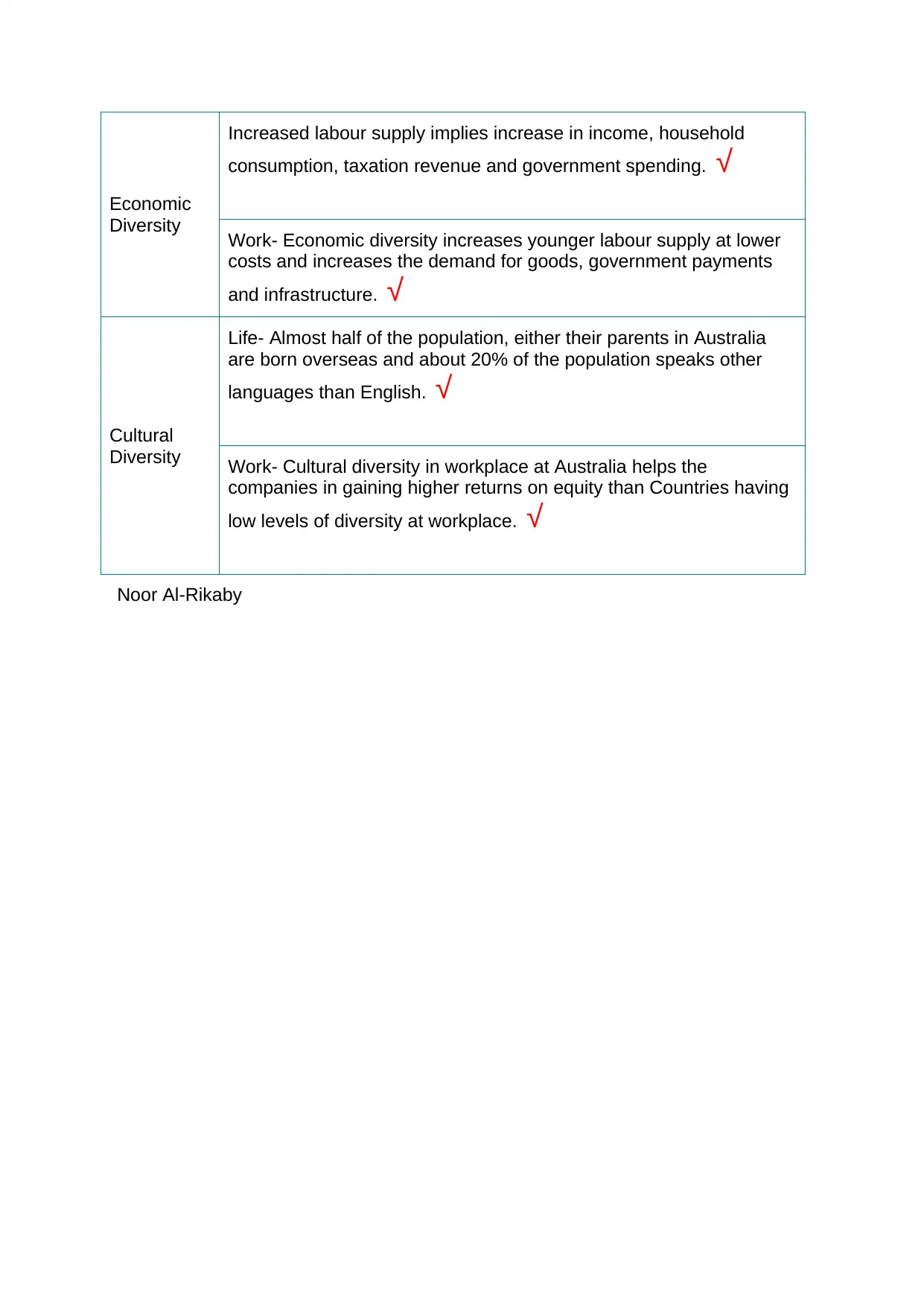
Economic
Diversity
Increased labour supply implies increase in income, household
consumption, taxation revenue and government spending. √
Work- Economic diversity increases younger labour supply at lower
costs and increases the demand for goods, government payments
and infrastructure. √
Cultural
Diversity
Life- Almost half of the population, either their parents in Australia
are born overseas and about 20% of the population speaks other
languages than English. √
Work- Cultural diversity in workplace at Australia helps the
companies in gaining higher returns on equity than Countries having
low levels of diversity at workplace. √
Noor Al-Rikaby
Diversity
Increased labour supply implies increase in income, household
consumption, taxation revenue and government spending. √
Work- Economic diversity increases younger labour supply at lower
costs and increases the demand for goods, government payments
and infrastructure. √
Cultural
Diversity
Life- Almost half of the population, either their parents in Australia
are born overseas and about 20% of the population speaks other
languages than English. √
Work- Cultural diversity in workplace at Australia helps the
companies in gaining higher returns on equity than Countries having
low levels of diversity at workplace. √
Noor Al-Rikaby
⊘ This is a preview!⊘
Do you want full access?
Subscribe today to unlock all pages.

Trusted by 1+ million students worldwide
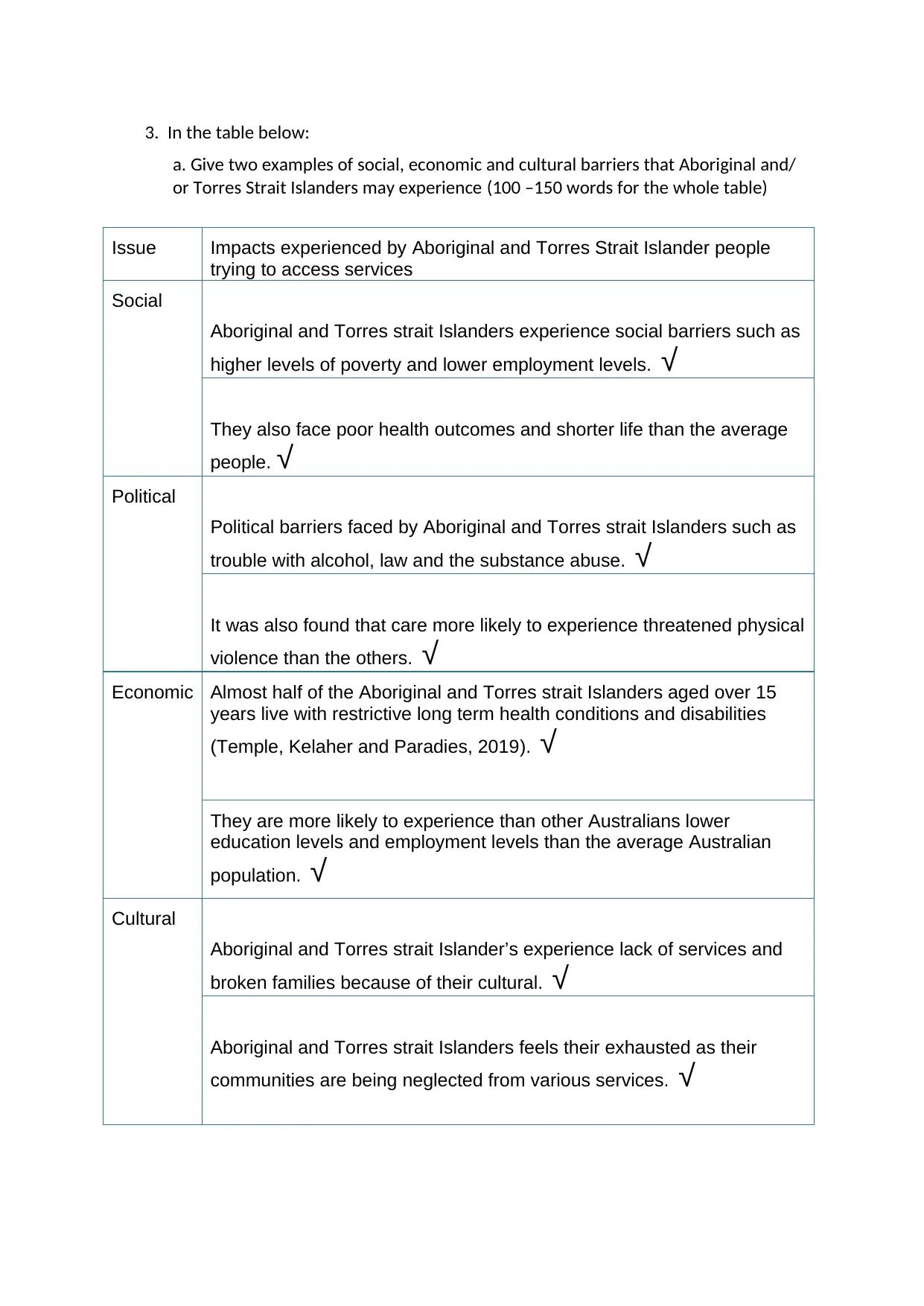
3. In the table below:
a. Give two examples of social, economic and cultural barriers that Aboriginal and/
or Torres Strait Islanders may experience (100 –150 words for the whole table)
Issue Impacts experienced by Aboriginal and Torres Strait Islander people
trying to access services
Social
Aboriginal and Torres strait Islanders experience social barriers such as
higher levels of poverty and lower employment levels. √
They also face poor health outcomes and shorter life than the average
people. √
Political
Political barriers faced by Aboriginal and Torres strait Islanders such as
trouble with alcohol, law and the substance abuse. √
It was also found that care more likely to experience threatened physical
violence than the others. √
Economic Almost half of the Aboriginal and Torres strait Islanders aged over 15
years live with restrictive long term health conditions and disabilities
(Temple, Kelaher and Paradies, 2019). √
They are more likely to experience than other Australians lower
education levels and employment levels than the average Australian
population. √
Cultural
Aboriginal and Torres strait Islander’s experience lack of services and
broken families because of their cultural. √
Aboriginal and Torres strait Islanders feels their exhausted as their
communities are being neglected from various services. √
a. Give two examples of social, economic and cultural barriers that Aboriginal and/
or Torres Strait Islanders may experience (100 –150 words for the whole table)
Issue Impacts experienced by Aboriginal and Torres Strait Islander people
trying to access services
Social
Aboriginal and Torres strait Islanders experience social barriers such as
higher levels of poverty and lower employment levels. √
They also face poor health outcomes and shorter life than the average
people. √
Political
Political barriers faced by Aboriginal and Torres strait Islanders such as
trouble with alcohol, law and the substance abuse. √
It was also found that care more likely to experience threatened physical
violence than the others. √
Economic Almost half of the Aboriginal and Torres strait Islanders aged over 15
years live with restrictive long term health conditions and disabilities
(Temple, Kelaher and Paradies, 2019). √
They are more likely to experience than other Australians lower
education levels and employment levels than the average Australian
population. √
Cultural
Aboriginal and Torres strait Islander’s experience lack of services and
broken families because of their cultural. √
Aboriginal and Torres strait Islanders feels their exhausted as their
communities are being neglected from various services. √
Paraphrase This Document
Need a fresh take? Get an instant paraphrase of this document with our AI Paraphraser

Noor Al-Rikaby
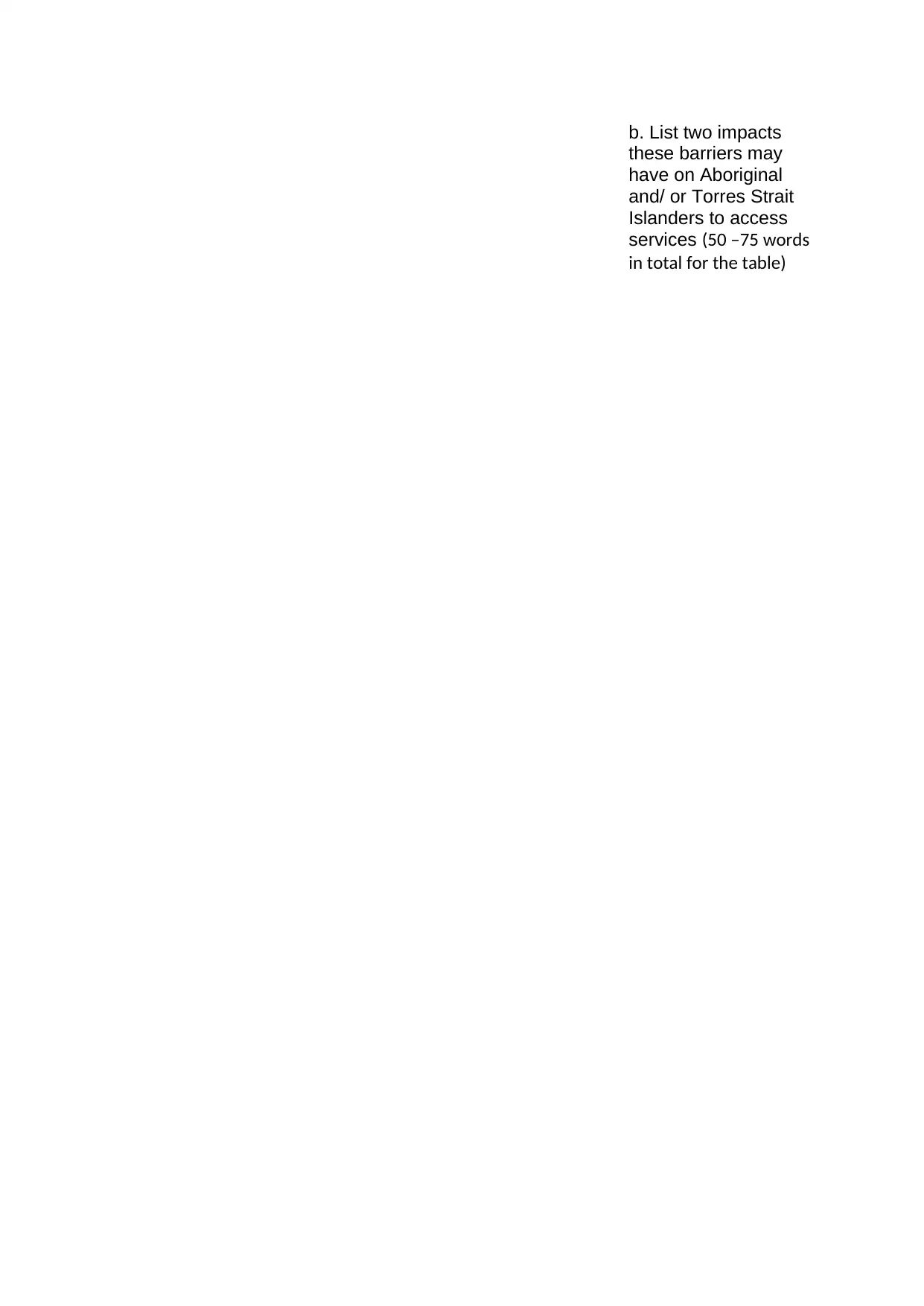
b. List two impacts
these barriers may
have on Aboriginal
and/ or Torres Strait
Islanders to access
services (50 –75 words
in total for the table)
these barriers may
have on Aboriginal
and/ or Torres Strait
Islanders to access
services (50 –75 words
in total for the table)
⊘ This is a preview!⊘
Do you want full access?
Subscribe today to unlock all pages.

Trusted by 1+ million students worldwide

Issue Impacts experienced by Aboriginal and Torres Strait Islander people
trying to access services
Social
impacts
Aboriginal and Torres Strait Islanders experience poor health
conditions.
Poverty, hunger, and malnutrition. √
Political
impacts
Issues of sewerage and clean water provisions. √
Ineffective government programs due to lack of coordination with
Aboriginal people. √
Economic
impacts
Higher unemployment rates because of droughts and other natural
climates. √
Low education levels due to decline in education services and school
attendance. √
Cultural
impacts
Clashes with residents because of cultural differences. √
Experience racism and sexism due to their cultures. √
trying to access services
Social
impacts
Aboriginal and Torres Strait Islanders experience poor health
conditions.
Poverty, hunger, and malnutrition. √
Political
impacts
Issues of sewerage and clean water provisions. √
Ineffective government programs due to lack of coordination with
Aboriginal people. √
Economic
impacts
Higher unemployment rates because of droughts and other natural
climates. √
Low education levels due to decline in education services and school
attendance. √
Cultural
impacts
Clashes with residents because of cultural differences. √
Experience racism and sexism due to their cultures. √
Paraphrase This Document
Need a fresh take? Get an instant paraphrase of this document with our AI Paraphraser
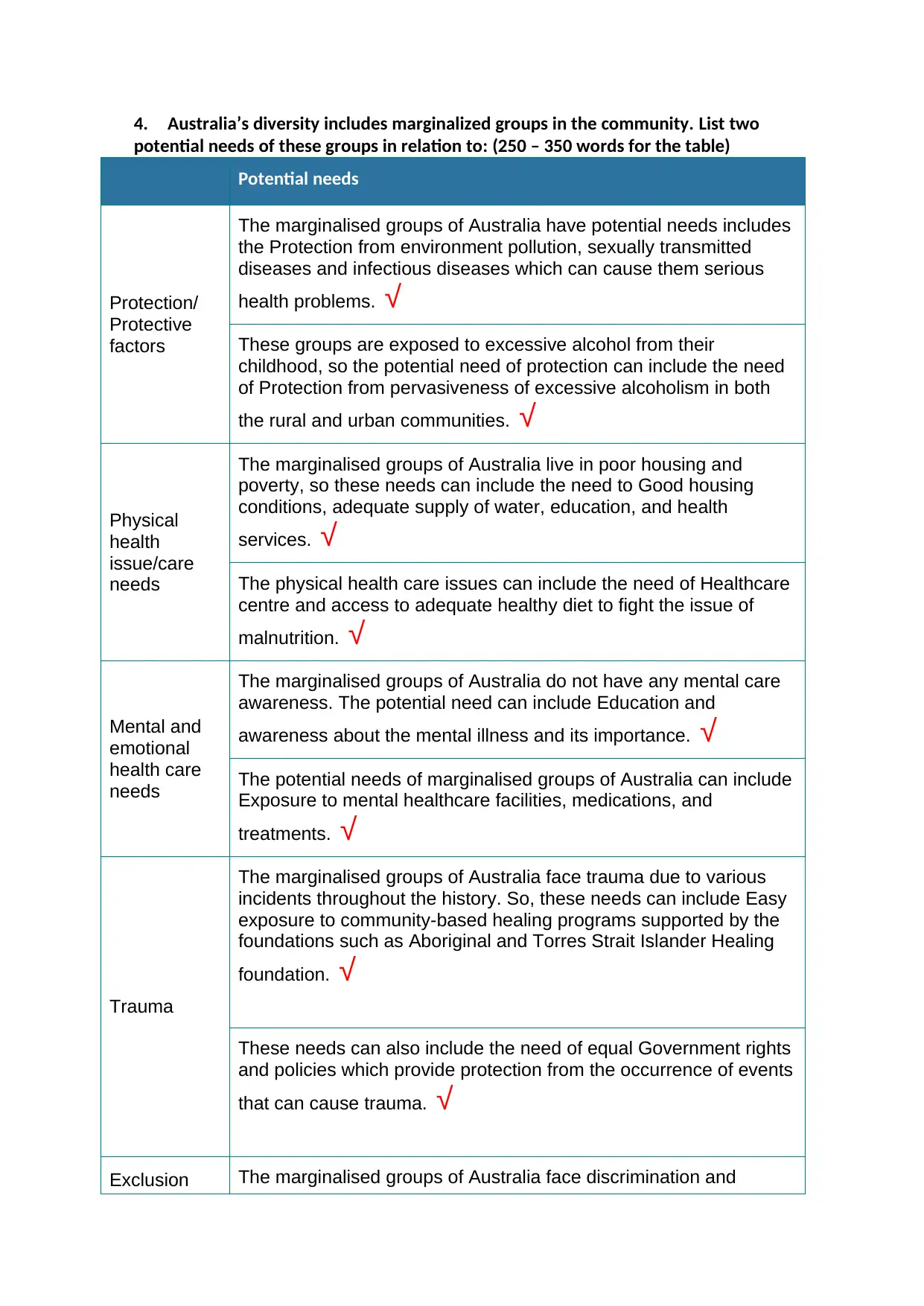
4. Australia’s diversity includes marginalized groups in the community. List two
potential needs of these groups in relation to: (250 – 350 words for the table)
Potential needs
Protection/
Protective
factors
The marginalised groups of Australia have potential needs includes
the Protection from environment pollution, sexually transmitted
diseases and infectious diseases which can cause them serious
health problems. √
These groups are exposed to excessive alcohol from their
childhood, so the potential need of protection can include the need
of Protection from pervasiveness of excessive alcoholism in both
the rural and urban communities. √
Physical
health
issue/care
needs
The marginalised groups of Australia live in poor housing and
poverty, so these needs can include the need to Good housing
conditions, adequate supply of water, education, and health
services. √
The physical health care issues can include the need of Healthcare
centre and access to adequate healthy diet to fight the issue of
malnutrition. √
Mental and
emotional
health care
needs
The marginalised groups of Australia do not have any mental care
awareness. The potential need can include Education and
awareness about the mental illness and its importance. √
The potential needs of marginalised groups of Australia can include
Exposure to mental healthcare facilities, medications, and
treatments. √
Trauma
The marginalised groups of Australia face trauma due to various
incidents throughout the history. So, these needs can include Easy
exposure to community-based healing programs supported by the
foundations such as Aboriginal and Torres Strait Islander Healing
foundation. √
These needs can also include the need of equal Government rights
and policies which provide protection from the occurrence of events
that can cause trauma. √
Exclusion The marginalised groups of Australia face discrimination and
potential needs of these groups in relation to: (250 – 350 words for the table)
Potential needs
Protection/
Protective
factors
The marginalised groups of Australia have potential needs includes
the Protection from environment pollution, sexually transmitted
diseases and infectious diseases which can cause them serious
health problems. √
These groups are exposed to excessive alcohol from their
childhood, so the potential need of protection can include the need
of Protection from pervasiveness of excessive alcoholism in both
the rural and urban communities. √
Physical
health
issue/care
needs
The marginalised groups of Australia live in poor housing and
poverty, so these needs can include the need to Good housing
conditions, adequate supply of water, education, and health
services. √
The physical health care issues can include the need of Healthcare
centre and access to adequate healthy diet to fight the issue of
malnutrition. √
Mental and
emotional
health care
needs
The marginalised groups of Australia do not have any mental care
awareness. The potential need can include Education and
awareness about the mental illness and its importance. √
The potential needs of marginalised groups of Australia can include
Exposure to mental healthcare facilities, medications, and
treatments. √
Trauma
The marginalised groups of Australia face trauma due to various
incidents throughout the history. So, these needs can include Easy
exposure to community-based healing programs supported by the
foundations such as Aboriginal and Torres Strait Islander Healing
foundation. √
These needs can also include the need of equal Government rights
and policies which provide protection from the occurrence of events
that can cause trauma. √
Exclusion The marginalised groups of Australia face discrimination and
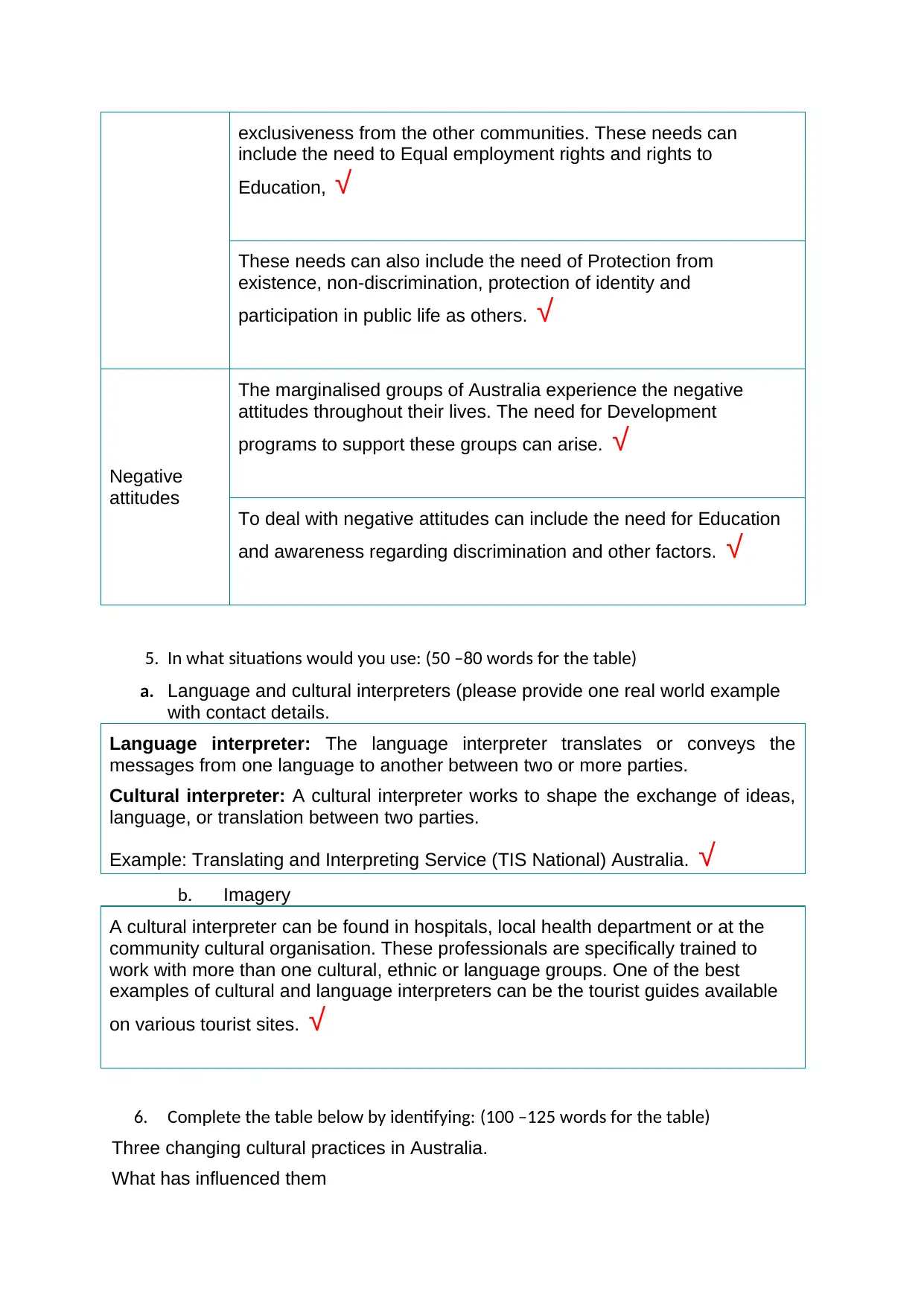
exclusiveness from the other communities. These needs can
include the need to Equal employment rights and rights to
Education, √
These needs can also include the need of Protection from
existence, non-discrimination, protection of identity and
participation in public life as others. √
Negative
attitudes
The marginalised groups of Australia experience the negative
attitudes throughout their lives. The need for Development
programs to support these groups can arise. √
To deal with negative attitudes can include the need for Education
and awareness regarding discrimination and other factors. √
5. In what situations would you use: (50 –80 words for the table)
a. Language and cultural interpreters (please provide one real world example
with contact details.
Language interpreter: The language interpreter translates or conveys the
messages from one language to another between two or more parties.
Cultural interpreter: A cultural interpreter works to shape the exchange of ideas,
language, or translation between two parties.
Example: Translating and Interpreting Service (TIS National) Australia. √
b. Imagery
A cultural interpreter can be found in hospitals, local health department or at the
community cultural organisation. These professionals are specifically trained to
work with more than one cultural, ethnic or language groups. One of the best
examples of cultural and language interpreters can be the tourist guides available
on various tourist sites. √
6. Complete the table below by identifying: (100 –125 words for the table)
Three changing cultural practices in Australia.
What has influenced them
include the need to Equal employment rights and rights to
Education, √
These needs can also include the need of Protection from
existence, non-discrimination, protection of identity and
participation in public life as others. √
Negative
attitudes
The marginalised groups of Australia experience the negative
attitudes throughout their lives. The need for Development
programs to support these groups can arise. √
To deal with negative attitudes can include the need for Education
and awareness regarding discrimination and other factors. √
5. In what situations would you use: (50 –80 words for the table)
a. Language and cultural interpreters (please provide one real world example
with contact details.
Language interpreter: The language interpreter translates or conveys the
messages from one language to another between two or more parties.
Cultural interpreter: A cultural interpreter works to shape the exchange of ideas,
language, or translation between two parties.
Example: Translating and Interpreting Service (TIS National) Australia. √
b. Imagery
A cultural interpreter can be found in hospitals, local health department or at the
community cultural organisation. These professionals are specifically trained to
work with more than one cultural, ethnic or language groups. One of the best
examples of cultural and language interpreters can be the tourist guides available
on various tourist sites. √
6. Complete the table below by identifying: (100 –125 words for the table)
Three changing cultural practices in Australia.
What has influenced them
⊘ This is a preview!⊘
Do you want full access?
Subscribe today to unlock all pages.

Trusted by 1+ million students worldwide
1 out of 35
Related Documents
Your All-in-One AI-Powered Toolkit for Academic Success.
+13062052269
info@desklib.com
Available 24*7 on WhatsApp / Email
![[object Object]](/_next/static/media/star-bottom.7253800d.svg)
Unlock your academic potential
Copyright © 2020–2025 A2Z Services. All Rights Reserved. Developed and managed by ZUCOL.





